Search the Special Collections and Archives Portal
Search Results
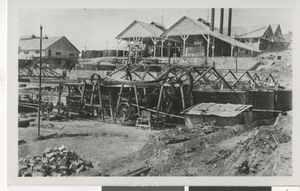
Photograph of a Mill, Sinaloa (Mex.), 1908
Date
1908
Archival Collection
Description
Worker stands atop machinery outside of mill in Sinaloa, Mexico.
Image
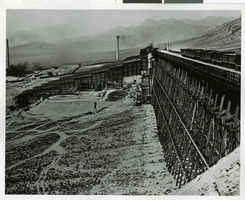
Photograph of mill, McGill (Nev.), 1910s
Date
1910 to 1919
Archival Collection
Description
McGill Mill before fire. The mill burned to the ground in July 1922.
Image
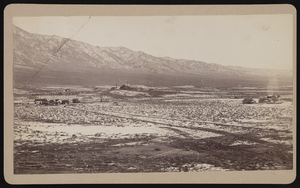
Sodaville Mill seen from Highway 95: photographic print
Date
1880 (year approximate) to 1915 (year approximate)
Archival Collection
Description
"Mt. Diablo M & M - Sodaville Mill long view". [Taken from present highway 95]. Stamp on back of photo: "Jas. H. Crockwell, travelling photogprapher. Viewing a specialty. Negatives preserved. Duplictes at any time. Alaways address. Salt Lake City, Utah."
Image
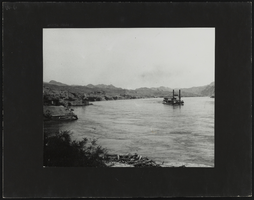
View of Mohave II and a mill on left: photographic print
Date
1870 (year approximate) to 1979 (year approximate)
Archival Collection
Description
From the KLVX Steamboats on the Colorado Photograph Collection (PH-00156)
Image
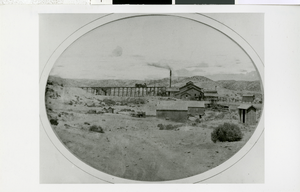
Photograph of a mill, Bullionville (Nev.), 1875-1893
Date
1875 to 1893
Archival Collection
Description
Pioche locamotive on an elevated railroad track running through a mill. The city of Bullionville was founded by John H. Ely and W.H. Raymond in 1870, but is now a deserted settlement and a ghost town.
Image
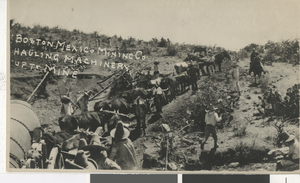
Photograph of workers moving mining machines, (Mex.), May 1911
Date
1911-05
Archival Collection
Description
Workers use cattle, horses, and covered wagons to haul mining machinery to the mines. Taken by Henry M. Corliss.
Image
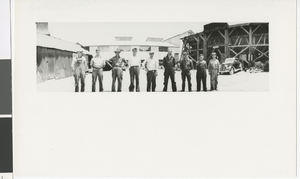
Photograph of mill workers, Pioche (Nev.), 1920s-1930s
Date
1920 to 1939
Archival Collection
Description
Mill workers at Ely Valley Mill, Pioche. Coal bins on right (now demolished). Coal loaded onto narrow gauge trains to Jackrabbit. Steam engines fired with coal hauled one to transfer station at Pioche depot. Buildings on left still exist. L-R 1. Bill Webb 2. Bob Schulz 3? 4? 5. Charlie Wilson, 6. James Deck 7. Charlie Van Allen 8. Shorty Long 9. Shorty Barnes.
Image
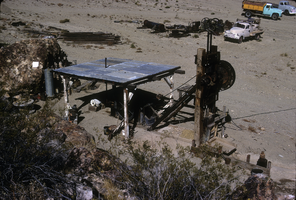
Slide of the old stamp mill, circa 1950s
Date
1950 to 1959
Archival Collection
Description
The old stamp mill, location unknown. A stamp mill (or stamp battery or stamping mill) is a type of mill machine that crushes material by pounding rather than grinding, either for further processing or for extraction of metallic ores. Breaking material down is a type of unit operation. A stamp mill consists of a set of heavy steel (iron-shod wood in some cases) stamps, loosely held vertically in a frame, in which the stamps can slide up and down. They are lifted by cams on a horizontal rotating shaft. On modern mills, the cam is arranged to lift the stamp from the side, so that it causes the stamp to rotate. This evens the wear on the shoe at the foot of the stamp. As the cam moves from under the stamp, the stamp falls onto the ore below, crushing the rock, and the lifting process is repeated at the next pass of the cam. Each one frame and stamp set is sometimes called a "battery" or, confusingly, a "stamp" and mills are sometimes categorized by how many stamps they have, i.e. a "10 stamp mill" has 10 sets. They usually are arranged linearly, but when a mill is enlarged, a new line of them may be constructed rather than extending the line. Abandoned mill sites (as documented by industrial archaeologists) will usually have linear rows of foundation sets as their most prominent visible feature as the overall apparatus can exceed 20 feet in height, requiring large foundations. Stamps are usually arranged in sets of five. Some ore processing applications used large quantities of water so some stamp mills are located near natural or artificial bodies of water. For example, the Redridge Steel Dam was built to supply stamp mills with process water.
Image
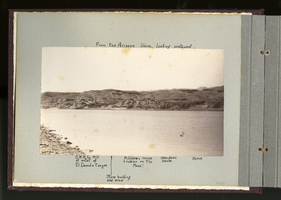
Photograph of Eldorado Canyon from the Arizona shore, Eldorado Canyon (Nev.), 1900-1925
Date
1900 to 1925
Description
Caption: From the Arizona Shore, looking southwest [above]. S.W.M. Co. Mill at outlet of El Dorado Canyon, Store building, end view, Millmen's camps and cabins on "the Mesa", abandoned adobe, home [below]
Image
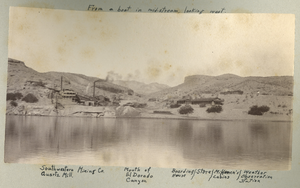
Photograph of Eldorado Canyon taken from the Colorado River, Eldorado Canyon (Nev.), 1900-1925
Date
1900 to 1925
Description
Caption: From a boat in mid-stream, looking west. [above] Southwestern Mining Co. Quartz Mill, Mouth of El Dorado Canyon, Boarding House, Store, Millmen's cabins, Weather Observation Station [below]
Image
Pagination
Refine my results
Content Type
Creator or Contributor
Subject
Archival Collection
Digital Project
Resource Type
Material Type
Place
Language
